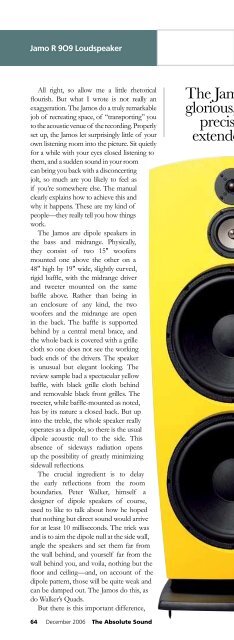You also want an ePaper? Increase the reach of your titles
YUMPU automatically turns print PDFs into web optimized ePapers that Google loves.
Jamo R 9O9 Loudspeaker<br />
All right, so allow me a little rhetorical<br />
flourish. But what I wrote is not really an<br />
exaggeration. The Jamos do a truly remarkable<br />
job of recreating space, of “transporting” you<br />
to the acoustic venue of the recording. Properly<br />
set up, the Jamos let surprisingly little of your<br />
own listening room into the picture. Sit quietly<br />
for a while with your eyes closed listening to<br />
them, and a sudden sound in your room<br />
can bring you back with a disconcerting<br />
jolt, so much are you likely to feel as<br />
if you’re somewhere else. The manual<br />
clearly explains how to achieve this and<br />
why it happens. These are my kind of<br />
people—they really tell you how things<br />
work.<br />
The Jamos are dipole speakers in<br />
the bass and midrange. Physically,<br />
they consist of two 15" woofers<br />
mounted one above the other on a<br />
48" high by 19" wide, slightly curved,<br />
rigid baffle, with the midrange driver<br />
and tweeter mounted on the same<br />
baffle above. Rather than being in<br />
an enclosure of any kind, the two<br />
woofers and the midrange are open<br />
in the back. The baffle is supported<br />
behind by a central metal brace, and<br />
the whole back is covered with a grille<br />
cloth so one does not see the working<br />
back ends of the drivers. The speaker<br />
is unusual but elegant looking. The<br />
review sample had a spectacular yellow<br />
baffle, with black grille cloth behind<br />
and removable black front grilles. The<br />
tweeter, while baffle-mounted as noted,<br />
has by its nature a closed back. But up<br />
into the treble, the whole speaker really<br />
operates as a dipole, so there is the usual<br />
dipole acoustic null to the side. This<br />
absence of sideways radiation opens<br />
up the possibility of greatly minimizing<br />
sidewall reflections.<br />
The crucial ingredient is to delay<br />
the early reflections from the room<br />
boundaries. Peter Walker, himself a<br />
designer of dipole speakers of course,<br />
used to like to talk about how he hoped<br />
that nothing but direct sound would arrive<br />
for at least 10 milliseconds. The trick was<br />
and is to aim the dipole null at the side wall,<br />
angle the speakers and set them far from<br />
the wall behind, and yourself far from the<br />
wall behind you, and voila, nothing but the<br />
floor and ceiling—and, on account of the<br />
dipole pattern, those will be quite weak and<br />
can be damped out. The Jamos do this, as<br />
do Walker’s Quads.<br />
But there is this important difference,<br />
64 December 2006 The Absolute Sound<br />
The Jamos have<br />
glorious, full, yet<br />
precise and<br />
extended bass<br />
and obvious it was, too, from the first note of<br />
the Rachmaninoff. The Jamos have glorious,<br />
full yet precise and extended bass, a bass<br />
undreamed of by any but truly enormous<br />
electrostatics. They are also free of the middlebass<br />
“hole” that afflicts so many point source<br />
speakers. And as the symphony proceeded,<br />
the Jamos turned out to have a dynamic<br />
capacity beyond electrostatic realms. I<br />
was tempted to subtitle this review “the<br />
electrostatic perfected.” And while that<br />
might have been a bit mean-spirited it<br />
would not have been inappropriate, for<br />
the Jamos do have the same kind of<br />
low distortion, transparency, coherence,<br />
and smoothness ’stats have, but with a<br />
power and fullness that electrostatics<br />
can only dream of. Though the<br />
orchestral range is fully covered, you’ll<br />
still need a subwoofer for earthquakes<br />
and pipe organs at full volume—even<br />
dynamic dipoles do have limits. By the<br />
end of the Rachmaninoff symphony, I<br />
was quite swept away, as if I had been<br />
at a concert.<br />
I tend to reserve the word “great” for<br />
things like the works of Beethoven and<br />
Michelangelo, but if I were to relax this<br />
rule, I would say this is without doubt one<br />
great speaker. It joins in my experience<br />
a select few—the McIntosh XRT28, the<br />
DALI Megaline, my Harbeth M40 (with<br />
subwoofer), the Gradient Revolution<br />
(with active, doubled bass units)—at the<br />
outer reaches of actually reproducing<br />
the live experience of large-scale music<br />
in a domestic environment, including a<br />
convincing sense of the original acoustic<br />
venue.<br />
The Jamo is not just superb at<br />
reproducing large-scale music. With its<br />
cost-no-object midrange and tweeter it<br />
does superbly well with the small-scaled<br />
music, too. The Water Lily recording of<br />
Arturo Delmoni playing solo violin was<br />
right on the mark as to tone, while the<br />
reverberant acoustics of the church where<br />
the recording was made were revealed<br />
naturally, with clarity but no exaggeration.<br />
(The disproportionateness of a pair of<br />
15" woofers to the 5.5" midrange and 1"<br />
tweeter is only visual.) Ulf Bastien’s voice in<br />
Schubert’s Winterreise [Ars Musici] sounded<br />
natural and integrated, and very much like<br />
my memory of Bastien’s voice (I have heard<br />
him sing this from close range in a domestic<br />
environment). And Ella Fitzgerald’s Let<br />
No Man Write my Epitaph [Classic/Verve]<br />
sounded beautifully natural.










